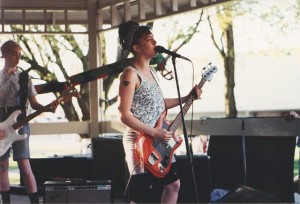By Danielle Lyons

The word “Riot Grrrl,” is synonymous with the word feminism. This underground hardcore punk movement started in the early 90’s in Washington, D.C. From their start, Riot Grrrl bands dealt with a big number of women’s issues they felt were not being talked about. Of course, the biggest theme of the Riot Grrrl movement was women’s empowerment. The movement sought to empower women by encouraging them to take their place in the men-dominated punk music scene. Women were encouraged to come to the front of the stage during Riot Grrrl bands’ shows; an uncharted territory for women at the time as they were often excluded. Some of the Riot Grrrl bands that emerged were Bikini Kill, L7, Heavens to Betsy, Bratmobile, and Sleater-Kinney. These proactive women did not only create music, they also created zines, political action, and the notorious Riot Grrrl Manifesto. It is a common misconception that this whole era of music and activism is anti-men. Molly Neuman of Bratmobile summarized it best, “We’re not anti-boy, we’re pro-girl.” In fact, despite initial aggression at the beginning shows, The Riot Grrrl Movement had its fair amount of men supporters such as, Kurt Cobain and Calvin Johnson.
Although the scene faded out in the late 90’s, their influenced is carried on by bands such as Gossip, Kitten Forever, and Skating Polly. Beth Ditto of Gossip stated that The Riot Grrrl Movement was, “Built on the floors of strangers’ living rooms, tops of Xerox machines, snail mail, word of mouth and mixtapes, Riot Grrrl reinvented punk.”